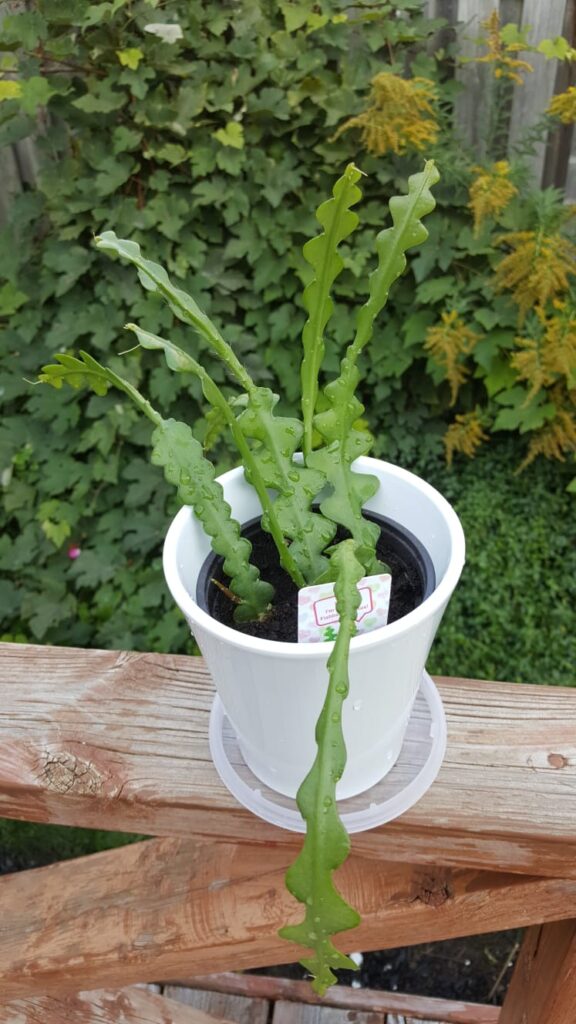
Hello Master Gardener,
Is it possible for the Epiphyllum Anguliger/Fishbone cactus to bloom flowers and bear fruits in Toronto? How to grow and care for this plant for it to reach this potential in Canadian weather? How long does it take to mature and flower? How to properly prune and propagate it if needed?
Many thanks for your valuable information!
Thank you for your question for Toronto Master Gardeners about your Fishbone cactus.
Epiphyllum anguliger (synonyms – Epiphyllum darrahi, Phyllocactus anguliger, Cryptocereus anthonyanus) or Fishbone cactus, which also goes by other common names such as moon, zig zag, or ric rac orchid cactus, is a tender epiphytic succulent native to Mexico. With attention to its growing requirements, it is possible to bloom a Fishbone cactus in Toronto. However, since this cactus variety is easily crossed with other related succulents, there are over 7,000 named hybrids. Without the name of the hybrid/cultivar, it is difficult to be certain as to when your cactus will reach blooming age. The age at which the Fishbone cactus will start to bloom ranges from four to seven years depending on the cultivar (RHS). Your plant looks healthy and appears to be made up of several cuttings which are possibly about a year old.
To grow this plant to blooming size, attention to the following is needed:
- Growing medium: The Epiphyllum genus has a similar growth to orchids in that it grows on tree supports rather than in soil. These succulents require fast draining cactus/succulent mix with the addition of 1 part peat moss and 1 part perlite added to increase water retention in order to avoid root rot. The sprawling growth particularly suits it to a hanging basket or plant stand. Repot every 3 years after blooming.
- Water: with lukewarm water when the top third of the potting mix feels dry. While overwatering is a problem for the plant, a common problem is also lack of water which can be seen in the leaves beginning to look desiccated. Water freely from the time of new growth in the summer until fall. Water less after flowering and in late fall through winter during the plants dormancy when the potting mix is dry down about half the mix. Symptoms of under-watering: little to no growth and drying leaves. Symptoms of overwatering: yellowing leaves, little growth and root rot. Watering from the bottom is preferred.
- Humidity: During fall and winter stand on humidity tray of pebbles and mist weekly – avoid water standing on leaves. In summer, this extra humidity is not necessary.
- Light: bright indirect light indoors, in summer; if outdoors, partial to full bright shade. Too much sun can cause red-tinged or burnt leaves.
- Temperature: summer – 16° – 25° C, winter – on the low end of this range during dormancy
- Feeding: apply a liquid fertilizer monthly following the package directions using a flowering fertilizer (higher potassium) from mid-summer through early fall and a balanced fertilizer the rest of the year.
- Pruning is ordinarily not required; however, remove yellowed, dying or dead growth. Overlong stems can be pruned and used for cuttings. Sterilize the pruning shears after each cut.
- Propagate by cuttings which are at least 12 cm long to increase chance of successful rooting. Use sterilized pruners for each cutting. Let the cut end dry for several days before potting up to about a third of the end in the potting mix. Mist on alternate days and supply bottom warmth. The cutting is successful when new growth appears next to the cutting.
Note: After maturity, the causes of failure to flower are not allowing plant a period of dormancy through fall and winter, cold water, over- or under-watering, and insufficient light.
Wishing you success in blooming your cactus – the effort is worth it. This type of cactus/succulent blooms at night: be sure not miss this event!

